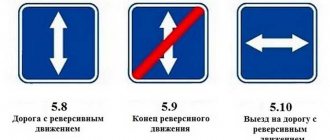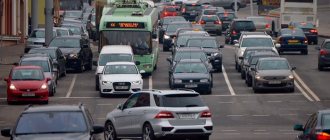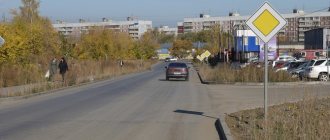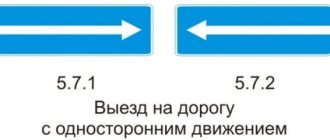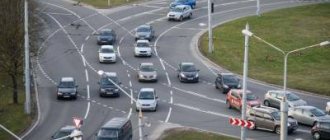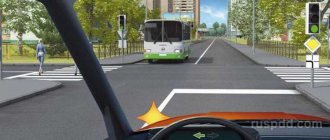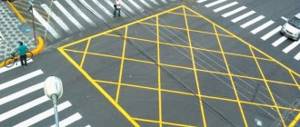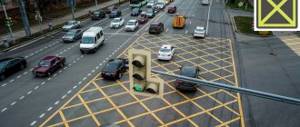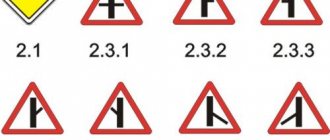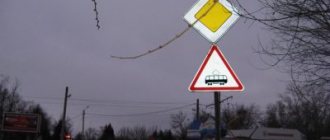Symbol meaning
The “One-way traffic” sign is installed in front of the road, along the entire width of which the movement of any motor vehicles must be carried out in only one direction. Externally, the symbol is presented in the form of a square, with a white arrow on a blue background. Some drivers commit serious violations by confusing it with the mandatory “Go straight” sign. Visually, the symbols are similar, but the latter is presented in the form of a circle with an arrow enclosed in it. It is important to distinguish between them, since they imply compliance with different rules.
A one-way traffic sign marks the beginning of a roadway on which all vehicles must travel in the same direction. In addition, it is also installed at intersections. Namely, at the intersection of parts where at least one road is “single-stream”. In this situation, the installation of the sign is due to the fact that drivers entering this area must timely assess the situation and follow the Traffic Rules.
What does a one-way road sign look like and what does it mean?
The beginning of a section of the roadway on which movement in only one direction is allowed is indicated by a special sign. In the traffic rules it is assigned the number 5.5 and it looks like a blue rectangle with a white arrow pointing upward.
Only one sign can set such a restriction. There are no other options in the Rules. There are designations indirectly related to 5.5., but only one directly establishes a section of a one-way road.
One-way traffic will remain in effect until about. As a general rule, this is done by means of 5.6 “end of a one-way road”, which looks like 5.5 with a diagonal red line through it.
After the end of a one-way section, the directions of the lanes are determined by markings, sign 5.15.7, or by drivers independently. For example, markings may be applied to the roadway, and if it is missing (as well as the markings that determine the directions of traffic lanes), then it is considered that the road is divided into two parts, one with traffic going in one direction, and the other in the opposite direction.
The “one-way traffic” sign is installed again after intersections that have a complex layout.
Another sign that is worth paying attention to is called “exit onto a one-way roadway.” It is installed in front of the roadway, perpendicular to the lane where traffic will begin in only one direction. Essentially, with its help, drivers learn that in a certain area they can only drive in the specified direction.
The “exit onto a one-way roadway” sign looks like a blue rectangle with a white arrow pointing to the right (5.7.1) or left (5.7.2). It is she who indicates in which direction travel is allowed.
The law does not prohibit crossing one-way roadways, that is, if there is a need and there is a continuation of the lane ahead, you can drive straight across the road.
From the opposite side of the one-way section, the sign will look like a prohibition on passing, indicated in the traffic rules under number 3.1. It is popularly called “brick” for its unique appearance. It looks like a white rectangle on a red background, and the sign itself is round.
Other signs
The sign with the arrow pointing up is not the only one indicating one-way zones. Other graphic designs are also installed on roadways.
These include:
- Sign "Exit onto a one-way road." Designed for drivers traveling on another roadway. This sign informs them that they are approaching the start of a one-way road. Moreover, it can be seen at an intersection if at least one section being crossed needs to move in one direction. It is important to pay attention to the direction of the arrow. This is the direction you need to turn. Accordingly, you cannot move in the opposite direction. In this case, you will enter the lane intended for traffic in the opposite direction.
- "End of one-way road" sign. Externally, it is the same square and a white arrow depicted on a blue background. But the sign is crossed out with a red line. This symbol is installed at the end of a one-way roadway. It is needed so that drivers can assess the situation and promptly change lanes to the outer lane, so as not to accidentally end up in a lane intended for cars moving in the opposite direction. As a rule, the sign is installed together with the warning symbol “Two-way traffic”.
There is always a sign on the back side of the road called “No Entry,” better known to drivers as a “brick.” Ignoring this symbol in many cases leads to an accident. This is due to the fact that inattentive drivers enter a one-way road, but from the other end, that is, they find themselves in the oncoming lane.
Other one-way traffic signs
Since the traffic rules also provide for other signs regulating one-way traffic, or used in connection with sign 5.5, we will briefly talk about each.
Signs 5.7.1 and 5.7.2
- Signs are located in front of side exits to those sections of the road on which traffic continues further in the direction specified by them.
- The image of all the signs is very similar, except for the direction given by the arrow, which can be used to make it easier to remember this series of signs.
- If the road from which the exit is made is already one-way, then the exit may not be marked with special signs. This situation does not raise questions among drivers.
- Turning in the opposite direction indicated by the arrow is strictly prohibited.
Often, it is this sign that causes difficulties for novice and inexperienced motorists who are unsure of their knowledge when leaving a two-way road. This is where they can get confused, and even make a mistake with his qualifications.
Sign 5.6
Indicates the termination of the one-way traffic regime. There are no other ways for this. The following sign is usually placed next to it.
Sign 1.21
Exit to a regular two-way road.
This sign is not always installed. Examples when it is possible to do without it:
- if the length of a one-way road is not more than 100 m,
- when a one-way road ends at a T-shaped intersection and becomes a square or roundabout
Sign 3.1
A red round shaped pointer with a white rectangle is the so-called “brick”. The use of this sign is not related only to the cases we are considering, but in this context it is used to avoid vehicles from driving into oncoming traffic. In this particular case, they are installed at the other end of a one-way street.
Sign 5.14
Placed above a specific lane, along which only route vehicles and taxi vehicles can move in the same direction as on other lanes. The movement of other vehicles that are not route vehicles is prohibited.
It is allowed to enter this lane when turning right, when changing lanes, if it is not separated by a solid line. It is possible to enter such a lane when entering a road with a right turn and for boarding and disembarking passengers, subject to the conditions of clause 18.2 of the traffic rules.
Coverage area
You must move in one direction until the corresponding sign appears, canceling the previous one. In this case we are talking about the symbol “End of a one-way road”.
In addition, the sign is valid until the nearest intersection. If a driver is driving along an area that has several roadway intersections, then he should know that on the other side the symbol is no longer relevant. In other words, beyond the intersection, the person driving the vehicle has the right to make certain maneuvers, which are prohibited by default by the “One-way traffic” sign.
Rules for installing a “one-way traffic” sign according to traffic rules
The one-way traffic sign must be installed correctly, that is, in accordance with current legislation. The rules for installing road signs are determined in accordance with GOST R 52289-2004.
Thus, paragraph 5.6.6 determines that the “one-way traffic” sign is installed in areas where traffic is allowed in only one direction.
GOST allows not to install a “one-way traffic” sign in the following cases:
- before the start of exits, if the intersection is made at different levels, when driving to service facilities where traffic is initially carried out in one direction;
- in front of a one-way road, which is separated from the roadway by appropriate markings or a boulevard, if the roads have a separate layout, if sufficient visibility is ensured on each side.
Sign 5.5 “one-way traffic” must be installed again after each intersection with a complex layout.
In accordance with paragraph 5.6.7 of GOST R 52289-2004, a sign indicating the end of a section with one-way traffic is placed at the end of the road, that is, just before the end of the one-way mode. The law allows for the installation of a preliminary sign; in the Rules it is designated by number 8.1.1.
Clause 5.6.8. defines the installation rules for entering a one-way road. Such signs are placed in front of side exits. If there are other signs, then all of them can be located on the same support, but the one indicating the exit to a one-way lane is placed at the very top.
The sign may not be installed at all, provided that exit from the adjacent territory will be possible only from the area indicated by the “one-way traffic” sign.
Entry into and exit from the symbol's coverage area
On a single-lane road, special rules apply. They are easy to remember. But, despite this, in reality, very often people driving vehicles have difficulties when entering and exiting a given area.
When the “One-Way Road” sign appears, it is recommended to change lanes to the right. This is the optimal way to travel. In addition, the need to perform certain maneuvers automatically disappears.
In some cases, the following difficulties arise:
- The one-way traffic sign is located behind the intersection, which can only be reached by turning right. In such a situation, you need to leave the intersection and change lanes. In other words, turn right as you would under normal circumstances. After this, the driver has the right to drive on any lane of the road intended for one-way traffic.
- The sign is installed at the left turn. In this case, the algorithm of actions is similar to that described above. Just before starting the maneuver you need to change lanes to the far left.
- Tram tracks are located along the route. In such a situation, access to a one-way road must be made from them. But the vehicle must not interfere with trams. In addition, the maneuver cannot be carried out if there are signs prohibiting it. It is also important to ensure that you do not accidentally end up on tram tracks intended for the opposite direction.
- When leaving a one-way road, you must turn left. To do this, you need to change lanes in a timely manner. However, it is important to remember that until the intersection, traffic continues to be one-way. It is when this maneuver is performed that the largest number of violations are recorded.
It is important to remember that the “One-way traffic” sign is located at the beginning of the right lane of the roadway. It is designed for drivers who continue to drive straight. Or they intend to make a right turn.
Why and where is it installed?
For what reason are restrictions introduced into measures to organize order on the roads that prevent travel on any of the streets in both directions? There are three possible rationales for answering this question:
- The volume of vehicles moving along a given route in one direction noticeably prevails over the opposite flow, which makes the existence of two-way traffic unreasonable on a particular section of communication routes.
- The technical criteria of the street classify it as narrow, which is dangerous for two-way traffic of motor vehicles.
- Streets or roads are passages to secondary elements of communication routes, which reasonably classifies them as one-way.
This traffic management device is installed at the very beginning of the roadway section. Also, according to the requirements of the legislator, sign No. 5.5. must be duplicated after each intersection. This will make it very clear to motorists what to expect from other cars and will allow them to take into account the relevant traffic regulations when performing maneuvers.
One-way traffic belongs to the category of special modes. It is not possible to determine it without special designations, with a number of exceptions.
Sign No. 5.5. It is permissible not to introduce it into the development of a road structure in the following cases:
- began connecting roads at intersections located at various levels of their interface;
- availability of bypass routes to service infrastructure facilities. If they represent the passing movement of the car exclusively in one direction;
- the presence of a road structure that is separated from sections of the road with oncoming traffic by constructive lanes or boulevards;
- Traveling on roads with separate routing, when sufficient visibility of each of the roadways is ensured.
In all four cases indicated above, one-way traffic is determined without special signs.
Even more detailed clarity in the organization of passing vehicles is provided by auxiliary technical safety equipment - No. 5.7.1 and No. 5.7.2. They are designed in the form of arrows pointing to the right or left. These signs mean that car owners are driving to a part of the road where movement in space can only be done in one direction.
The sign shows that the one-way road is directed to the left, therefore turning right is prohibited
These signs are installed along the perimeter of all cross traffic routes if the road elements that the car owner crosses are one-way. Turning the sign specifies which direction of the route the car owner needs to move.
Movement in the opposite direction of the arrow is strictly prohibited
One of the most careless violations that can happen on an engineering structure with one-way traffic is entering the lane for fixed-route traffic. Despite the fact that this element of the roadway is passing, driving into its limits does not seem permissible . Otherwise, the car owner will face monetary punishment.
Movement in forward direction
All drivers are required to comply with the terms of the mandatory symbol. Regardless of which “One-way traffic” sign is installed (the beginning of the zone or the exit to this area), the person driving the vehicle must move in the direction indicated on the arrow. That is, in this case, driving in a forward direction is the best option. But there is one caveat. It is important to carefully assess the situation so as not to end up in the lane intended for traffic in the opposite direction.
Right turn
In this case, several scenarios are possible:
- The driver should not encounter any difficulties when exiting a one-way road. You must first move into the outer lane and make a turn.
- The driver needs to turn right within the area of the sign. In such a situation, you also need to take an appropriate position and drive into the adjacent territory, for example, into a yard.
Thus, right turns are not prohibited in the area covered by the One-Way Traffic sign. Drivers should not be afraid to carry out this maneuver either at intersections or on less busy roads.
Left turn
The “One-way traffic” sign prohibits this. This is a rule with no exceptions. If the driver is moving in a straight direction, he cannot turn left, since in this case he will inevitably end up in the oncoming lane. This significantly increases the risk of an accident. In addition, the violator in such situations is subject to administrative liability. As practice shows, most often the driver’s license is confiscated from the person driving the vehicle.
U-turn
This maneuver is also prohibited. This is due to the fact that a driver who turns around will end up in a lane intended for vehicles moving in the opposite direction.
A different situation arises if a person is driving along the road and sees a sign “Exit to one-way traffic.” In this case, two scenarios are possible. The driver has the right to turn right and be within the area of the sign. The start of one-way traffic means that the person can no longer turn around or turn left. He must move in a straight direction or go to the right.
In the second case, the driver may not enter a one-way road. In such a situation, he can easily make a U-turn. This issue causes disagreement among many drivers. They are due to the fact that when turning, the vehicle will inevitably end up in oncoming traffic. However, you need to understand that a turn is a maneuver. It does not imply driving in the oncoming lane. Therefore, this is not a violation.
Road signs “No Entry” and “No Traffic”
The first group of signs are signs prohibiting movement or entry. The entry prohibition sign is a red circle with a white horizontal line in the middle, which is popularly called a “brick” (the “No Entry” sign is sign 3.1 of the Traffic Regulations).
See also: How to avoid getting caught by the traffic police on the road
This road sign prohibits the entry of all vehicles. The “brick” can be seen on one-way roads, as well as at entrances, where it is installed in order to prevent oncoming traffic. We also remind you that this road sign is valid until the first intersection. This road sign can also be seen on public transport lanes and at bus terminals. In most cases, the “brick” sign does not apply to public transport.
The “No movement” sign (traffic rules sign 3.2) is a white circle with a red round frame. This sign indicates that there is no road ahead - traffic is prohibited. This sign applies to all types of transport, except:
- route vehicles
- motor vehicles driven by disabled people of groups 1 and 2, transporting such disabled people or disabled children, if the identification sign “Disabled” is installed on these vehicles
- vehicles of federal postal service organizations that have a white diagonal stripe on the side surface on a blue background, and vehicles that serve enterprises located in the designated zone, and also serve citizens or belong to citizens living or working in the designated zone. In these cases, vehicles must enter and exit the designated area at the intersection closest to their destination.
The “No Traffic” sign is valid until the first intersection.
Stopping and parking
Drivers have the right to park on both the right and left sides of the roadway. But this is only when we are talking about a populated area, and there are no corresponding prohibitory signs.
Trucks weighing more than 3.5 tons are prohibited from parking on the left side of the roadway. They can only stop for the purpose of loading/unloading. If there is a lane on the roadway designated for the movement of route vehicles, all vehicles are prohibited from parking on the left side. Outside the populated area, the roadside should be used to stop or park. Parking is only permitted on the right side of the roadway.
Parking and stopping in the area covered by the “one-way traffic” sign
A stop is a short-term cessation of movement, used for boarding or disembarking passengers or loading and unloading vehicles. But parking is already a long process.
As a general rule, stopping and parking are permitted on the right side of the curb (clause 12.1 of the traffic rules). However, one-way traffic has its own characteristics. Thus, in the second paragraph of clause 12.1 of the traffic rules it is stated that you can park your car on the left side on one-way roads. At the same time, there is a restriction for trucks (parking is prohibited if the weight is more than 3.5 tons, you can only stop for unloading or loading).
Another important point! Stopping on the left side will be allowed only within populated areas. In other cases it is not allowed.
Reverse
When entering the beginning of a one-way road, many drivers are afraid of the sign. It is important to remember that the symbol prohibits U-turns and left turns. Reversing is allowed. But before performing this action, the driver must make sure that he will not interfere with other vehicles.
The most striking example is the following: a motorist accidentally passed the entrance to the yard on the right and does not know whether he can put the car in reverse and then move into the adjacent territory. This action is permitted and does not entail administrative liability. But first you need to make sure that it is safe to do so.
The situation is different with intersections. At any road intersections, reversing is strictly prohibited. If the driver has passed the desired section, he is obliged to move in a forward direction until it becomes possible to turn right.
Administrative responsibility: penalties
This issue is regulated by the Code of Administrative Offenses (Article 12.16). If a driver violates traffic rules in the area covered by a one-way road sign, he faces a fine. Its size is 5 thousand rubles.
An alternative penalty is the confiscation of the driver's license for a period of at least 4 and maximum 6 months. If the violation is repeated, the driver’s license may be revoked for 1 year.
The choice of punishment is made by the court. In most cases, this authority decides in favor of withdrawing the driver's license.
